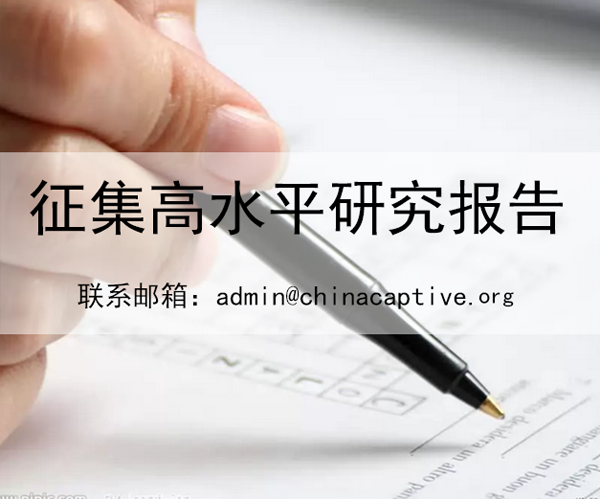Turning Crisis into Opportunities: Hong Kong as an Insurance Hub with Development Focuses on Reinsurance, Marine and Captive
Executive Summary
As a major Asian insurance centre, Hong Kong is facing a serious challenge and is lagging behind its Asian competitors in many areas, especially reinsurance, marine and captives, which are crucial elements for Hong Kong’s comprehensive development as a financial centre and as a super-connector in the Belt and Road Initiative.
The recent departure and/or downsizing of Munich Reinsurance Company1 and other global reinsurance companies highlight the failings of Hong Kong for the reinsurance industry. Further departures are expected in the near future if action is not taken.
The position of Hong Kong as Asia’s reinsurance centre was lost to Singapore after 1997. Over the past 20 years, the number of captives and volume of reinsurance and marine business in Singapore have grown significantly, contributing to its development as a regional insurance hub.
Following the implementation of China Risk Oriented Solvency System (C-ROSS)2 on 1 January 2016, more reinsurance placement will be diverted to on-shore reinsurance companies in Mainland China.Insurers and brokers are also diverting reinsurance businesses away from Hong Kong to Singapore, Shanghai and other reinsurance centres to concentrate their reinsurance purchases and enjoy economies of scale and tax benefits offered by these hubs.
Recommendations
A company established in Hong Kong in 1962 and is currently the second largest reinsurer in the world. CIRC is instituting sweeping changes through its three tiered China Risk Oriented Solvency System (C-ROSS) framework that will dramatically impact how reinsurers conduct business. It will strengthen local capital requirements, risk management and transparency disclosures – bringing Mainland China in line with, and in some cases overtaking, global standards. The C-ROSS framework essentially imposes higher capital charges on local insurers in Mainland China who purchase offshore, including Hong Kong based, reinsurance than if the local insurer purchase reinsurance inside Mainland China.
In addressing the failures of Hong Kong in establishing itself as a regional hub for insurance, a series of changes need to be made, including:
1. C-ROSS – An agreement with the China Insurance Regulatory Commission (CIRC) to apply a ‘Special Administrative Region (SAR)’ status to Hong Kong under C- ROSS.
Hong Kong is currently grouped ‘offshore’ with all other non-Chinese jurisdictions. This would involve creating a new category between ‘Onshore’ and ‘Offshore’. This amendment is our highest priority for stopping further loss of business and talents to the other regional financial centres and for re-routing insurance business from other offshore centres to Hong Kong. Through this SAR status, some preferential treatment to domestic insurers and reinsurers can be extended to companies with SAR status, so that (i) Hong Kong companies can develop together with the insurance and reinsurance business in Mainland China, (ii) Mainland Chinese companies can enjoy the comprehensive range of sophisticated corporate insurance products and risk transfer solutions offered by Hong Kong insurers in their Belt and Road businesses, and (iii) The insurance authorities in Mainland China and Hong Kong can make some joint efforts to develop cooperative oversight, especially for businesses relating to the Belt and Road Initiatives to maintain financial stability and customer protection.
Hong Kong insurers and reinsurers have played a critical role in supporting Mainland Chinese companies to transfer and manage their risks, particularly as they expand into new territories, specifically in the Belt and Road Initiative. Mainland Chinese companies and insurers will be able to take advantage of the substantial benefits in terms of efficiency, best practices, language and ease of doing business by transacting reinsurance in Hong Kong.2. Tax – To stay competitive in the region, Hong Kong can consider:
(i) extending the current offshore reinsurance tax incentive to direct insurers in respect of their reinsurance businesses, and to cover reinsurance of offshore life risks;
(ii) introducing tax incentives to insurers on marine hull and liability policies;(iii) offering tax incentives to brokers to encourage the placement of insurance and reinsurance businesses in Hong Kong;
(iv) providing tax concession to Hong Kong registered/flagged ship owners while taking insurance policies from Hong Kong insurers;
(v) providing tax incentives to Hong Kong insurers to place their reinsurance businesses with Hong Kong registered reinsurers; and
(vi) speeding up the negotiations of Double Taxation Agreements with other countries to match with those of Singapore and London.3. Insurance Regulatory Framework – We suggest the insurance regulator to:
(i) speed up the implementation of risk based capital regime tailored for Hong Kong;
(ii) issue guidance notes on captive management, risk management, Insurance-linked Securities (ILS)3 and corporate governance; and
(iii) have dedicated resource to promote the use of captive and Hong Kong as an insurance centre.
4. Business promotion – The Financial Services Development Council (FSDC) can team up with the Hong Kong Maritime and Port Board to organise business development workshops for getting both the insurance companies and the ship owners/ ship registrars together to develop further marine insurance business.
5. Talent development – To incubate a line of young talents by setting up specific insurance courses in tertiary institutions and enhance the current Continued Professional Development programmes.
Hong Kong has all the necessary ingredients. Hong Kong’s politically neutral status can attract vast insurance and reinsurance businesses from North Asia business regions like Mainland China, Japan, Korea and Taiwan and become a comprehensive financial centre.
Support from the Government is crucial on talent development and to raise the profile of Hong Kong as an Insurance Underwriting and Broking Centre. More regular regional and global insurance summits and conferences should be organised in Hong Kong. We are keen to arrange regular outreach sessions with Financial Services and Treasury Bureau (FSTB) and Independent Insurance Authority (IIA), gather relevant stakeholders to work together and turn the aforementioned crises into opportunities.
Section 1 – Reinsurance
1.1 Our Goal
To create a world-class reinsurance hub in Hong Kong.
1.2 Facts and Figures
The fundamental of reinsurance would mean:
The proper risk transfer within the insurance industry which in turn helps out its overall stability and integrity – benefit from balance sheet reserves / capital relief as a result of this risk transfer.
Increasing the depth and width of coverage when insurance companies are protected and secured by robust reinsurance arrangements. This allows insurers to, more affordably, offer more capacity to the market with a wider range of insurance solutions/ products.
Helping with analytical and decision-making process – reinsurer is in close partnership with insurer, supporting better risk analysis, calculation of accumulated exposure, new product development and pricing, etc.
Providing an array of services through the sharing of technology, training, analytical assessment and even management and accounting.
Reinsurance transactions often attract significant premiums; it is, for example, common to see single transactions worth millions of US dollars. Bespoke deals such as reinsurance pooling, Cat-Bond and ILS vehicle, requiring expertise from across the financial industry such as security rating agency, specialist lawyers, catastrophe modelling, external actuary, investment manager and even the regulator can be engaged for their services.
The most recent report (1st H/Y 2016) shows an overall ILS (global) transactional volume of USD75bn (HKD585bn) which is almost a 300% growth over the past decade. By and large, we see a clear tendency for reinsurance transactions shifting from a traditional practice – facultative and treaty underwriting to a more solution driven practice such as capital market solutions and private transactions.
Reinsurance trading on pure domestic Hong Kong insurance business unfortunately is not sustainable as total general insurance direct premium was only HKD35bn by Year 2015. Medical and health insurance sector showed a robust and promising increase of 16.86% in premium volume, other sectors had developed into a disappointing trend of just 3.68% combined total increase. Domestic Hong Kong general insurance market has been famous for its fierce price competition, which, with the slowing down of the local/global economy and coupled with no major new infrastructural projects ahead (except projects for the third Airport Runway and Kai Tak Redevelopment) would lead us to expect insurance growth momentum at a snail’s pace in the coming years.
Ceded reinsurance premium for general insurance business is averaging at 30% or about HKD10bn for which its absolute size is definitely small versus the global market average. Ceded reinsurance premium for life insurance on the other hand is averaging at 10% and very much in the hand of a few major life reinsurers. Ceded life portfolios are adhering to distressed life exposures, risk accumulation exposures as well as risk transfer for investment risks.
Figure 1: Hong Kong Primary Market Written Premiums from 2005 to 2015
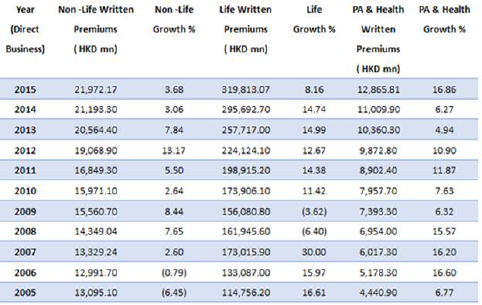
Figure 2: Premium Ceded in Hong Kong (including Non-life and Life)

(source: AXCO Global Statistics)
1.3 Growth Potential for Hong Kong Reinsurance Market
Whilst the domestic insurance market does not seem large enough to allow Hong Kong in becoming the largest Asian reinsurance hub, we are lucky enough for being right at the doorstep of Mainland China and from there, the promising growth as well as ever increasing sophistication in terms of reinsurance transactions is eye-witnessed. Hong Kong is well-positioned in the perspective of integration of financial system as well as geographic proximity of between the two regions and therefore enabling us to offer our hand to aid the further development of the reinsurance industry there. Reports show that Mainland China's reinsurance market was valued at HKD273bn in 2013 and is expected to reach up to HKD1,544bn by 2020, fuelled by explosive growth in the primary general and life insurance markets.
Figure 3: Top 10 Region of Primary Insurance Market by Written Premiums in 2015

(source: Munich Re)
1.3.1 Re-routing of Mainland China and North Asia Reinsurance Business to Hong Kong
FSDC published a paper in December 2014 titled “Developing Hong Kong as an Offshore RMB-denominated Reinsurance Centre”. The Paper estimated that HKD32.4bn of Mainland Chinese insurance premiums were ceded to offshore markets like Bermuda, Continental Europe, Singapore and the UK back in 2012. Majority of these could have been re-routed to Hong Kong with relatively little change in local infrastructure when compared to RMB-denominated reinsurance (estimated at HKD9.2bn). Based on the figures, if non-RMB reinsurance is included, new business prospect for Hong Kong could be increased by as much as HKD24bn to HKD50.4bn, about double of the current volume.
Potential flow from other North Asian markets, such as Japan, South Korea and Taiwan on the other hand is estimated at a total of another HKD6bn premium volume.
1.3.2 ILS Market
ILS products are ironically under-developed in Hong Kong with over 75% ILS transactions still being completed in Bermuda, despite our integrated financial system and adequate supply of talents from across the financial industry. In 2015 the non-life ILS market grew by USD3.2bn (HKD25bn) to hit a total value of USD180bn (HKD1,404bn) when global investors are looking for a better yield. Although, reinsurers operating in Asia have started to seek opportunity to make use of ILS and the capital market, the rapid growth of ILS in developed market has yet to get its footprint in Asia, with the exception of Japan for risk transfer on natural peril exposures such as earthquake and typhoon. Stemming from the rapid development of Mainland China insurance industry – absolute size, sophistication of insurance transactions as well as for the sake of reinsurance efficiency/ effectiveness, we firmly believe ILS are going to be an important driver of the future growth of Hong Kong reinsurance industry.
1.3.3 RMB Reinsurance in Hong Kong
Mainland China is clearly the driver of the global insurance economy, but Hong Kong has yet to fully leverage its advantage and fully engaged of being the strategic linkage between the international market and Mainland China. If reinsurers based in Hong Kong were allowed to write RMB-denominated reinsurance business this could help the Central People’s Government to speed up the process of RMB internationalisation. This new cross-border reinsurance channel could increase the Hong Kong reinsurance market size in an explosive way as well as providing Hong Kong a stronger muscle in competing with other reinsurance hubs – Bermuda, London, Singapore and Zurich, on the international stage.
1.4 Benefits for Hong Kong as a Reinsurance Hub in Asia
Filling the gap of our broad range of financial services capability as reinsurance has always been considered somewhat lagging behind the international standard.
Creation of a reinsurance marketplace leading to a significant offshore premium income and flow of funds from around the globe, not to mention the influx of industrial talents.
Global reinsurance players’ help improving further our international experience, underwriting skill, risk management practice, corporate governance as well as operational standard.
Talent development and employment opportunity for local graduates.
The influx of reinsurance players shall create a demand for auxiliary professional services such as legal, consulting, accounting, risk engineering, actuary and IT.
Reinsurance trading is capital intensive by nature and building Hong Kong into a reinsurance hub would lead to the influx of a significant amount of stable/ long-term funds into the local capital market.
Figure 4: Global Reinsurer Capital (@ 1Q 2016)

1.5 Our Recommendations
1.5.1 Support from the Government
Regulators and governments in many jurisdictions have adopted robust policies to assist local reinsurers to gain market share and to expand themselves overseas. In view of the global trend, the Hong Kong Government should consider shifting from the non-intervention policy and come up with plans to assist the local reinsurance industry.
Negotiating with the Central People’s Government for preferential or HKSAR treatment to Hong Kong based and registered reinsurers under the C-ROSS, as opposed to being recognised as offshore.
The C-ROSS has been effective in Mainland China since January 2016. In essence, it is the Chinese version of a risk-based-capital regime. The C-ROSS provides for, inter alia, preferential treatment to domestic insurers and reinsurers, which in turn, encourages reinsurance premiums to be kept in Mainland China with the side effect of further drainage of talent and reinsurance premium from Hong Kong.
Speeding up the negotiation of DTAA with other jurisdictions.
Liaising with the Central People’s Government to re-route Mainland Chinese reinsurance businesses from other existing offshore locations to Hong Kong.
Co-operating with the Central People’s Government on matters relating to the reinsurance industry. For example, the Government may offer training to managerial grade insurance practitioners from Mainland China, with an aim to improve their knowledge in international market. (See also sub-section 1.5.2 – Talent Development below)
Providing further tax incentives for conducting off-shore reinsurance business in Hong Kong. Hong Kong offers tax incentives to professional reinsurers on offshore non-life business at 50% of the normal profit tax rate. Nevertheless, the incentives do not extend to direct insurer and do not cover offshore non-life risks. Hence, extending the incentives to cover direct insurer and offshore non-life risk shall encourage insurers and reinsurers to start or expand their reinsurance business in Hong Kong. Note that Singapore also offers a 10% concessionary tax rate on reinsurance for both offshore life and non-life risks.
Promoting Hong Kong as a reinsurance hub.
There ought to be active facilitation, hosting or sponsorship of regular marketing event, such as Lloyd’s regional conferences and Marine Insurance Conference.
The Government to proactively approach specific reinsurers with an aim to inviting them to set up their trading platforms in Hong Kong.
Gaining support from the Insurance Regulator. The IIA will come into operation by 2017. We have great enthusiasm on the IIA regime in relation to its raising the standard and profile of the Hong Kong insurance and reinsurance industry.
(i) To speed up the study, consultation and implementation of a risk-based-capital regime tailored for Hong Kong insurance industry – similar regime has actually become the benchmark or indeed minimum requirement for insurers and reinsurers worldwide.
(ii) To enhance the overall regulatory framework through the issuance of guidance notes. Such notes would cover area such as corporate governance and shall be enforceable to all insurance market players. These would help reinforcing market’s confidence in reinsurers based in Hong Kong.
(iii) To increase the collaboration with the Government and local industry bodies, with an aim to develop and formulate goals and policies in the perspective of common market interest.
(iv) To provide support and maintain regular dialogue with the industry in an open-minded approach, with utmost transparency and clear vision.
1.5.2 Talent Development
Whilst the Government is working hard to nurture talents for the Hong Kong insurance industry, they may consider further initiating, encouraging and co-operating with the reinsurance industry on the following areas:
To design and set up courses, at local tertiary institutions, with an aim to assisting graduates to take up responsibilities upon joining the industry.
To conduct career talks at local tertiary institutions to attract talent from various backgrounds.
To target fresh graduates from overseas, who are Hong Kong citizens, whereas promotion can be done through alumni networking and career talks.
To obtain sponsorship from the insurance industry for the funding of courses.
To expand/refine the internship and/or mentorship program to all local undergraduates with insurance-related studies.
To enhance further the Continued Professional Development (CPD) program. The Government and Hong Kong Federation of Insurers (HKFI) may jointly set up an Education Fund and invite retired insurance practitioners, who came from different areas of insurance and reinsurance practice such as administration, account, actuary, claims management, investment, legal, risk engineering, risk management, facultative and treaty underwriting, to conduct regular short term courses (5 to 10 days) with discounted fee to be offered to:-
(i) Local insurance practitioners;
(ii) Invited insurer, reinsurer and regulator from Mainland China (invitation to be sent via the Central People’s Government as a contribution to the growth and prosperity of the insurance industry in Mainland China); and
(iii) Invited insurers within Asia.
1.5.3 Technology
Technology is now an indispensable element in our industry and digitalization holds the key of success to our future. The ability to analyze vast historical data will have a deciding impact on risk selection, premium pricing and claims administration. Emphasis should be placed on:
(i) Enhancing actuarial studies in general reinsurance practice. The reason is twofold – 1) to develop Hong Kong into a regional hub in actuarial practice; 2) to encourage students to start their career life in the local reinsurance industry.
(ii) Consulting local market players on the viability of setting up an integrated computer platform for the facilitation of policy documentation and/or the processing of claim payment.
Section 2 – Marine Insurance
2.1 Our Goal
To become a leading international marine insurance market (See Appendix 1 for figures on global marine premium in 2015).
Hong Kong has the fourth largest shipping registry in the world representing 10% of total number of vessels, however, the total marine premium purchased in Hong Kong only represents 0.6% (global total at HKD231.7 bn). There is room for further development.
2.2 Our Strengths / Opportunities
Hong Kong is a leading international maritime centre. Hong Kong has a good cluster of maritime service providers including ship owners, ship managers, ship brokers, maritime legal service providers, maritime arbitration and of course marine insurance.
International marine insurance talents and specialists have set up their bases in Hong Kong for decades. The industry history and experience is longer and deeper than that of the other regional centres, such as Singapore and Shanghai.
Hong Kong’s Shipping Registry is the fourth largest in the world by reference to tonnage. The Hong Kong Shipping Registry has expanded significantly in the last two decades. In 2015, the total tonnage of ship registered in Hong Kong had reached 158 million dead weight tonnes (DWT) with 2,022 registered vessels owned by either local, Mainland Chinese or overseas ship-owners. This is a remarkable strength envied by other international maritime centres. (See Appendix 2 for a list of the top 10 ship register in the world)
Hong Kong has world class transportation infrastructure of container terminals, cruise terminals, airport and logistics network, and is well prepared for potential growth in future.
Hong Kong is Asia's World City. It is a vibrant centre of international trade.
International Union of Marine Insurance (IUMI) have announced in October 2016 of the appointment of Hong Kong Federation of Insurers (HKFI) to set up its first Asian chapter in Hong Kong.
The Hong Kong Maritime and Port Board was established in April 2016 and chaired by the Secretary for Transport and Housing, with the goal to promote maritime and maritime related services industries for Hong Kong.
2.3 Our Weaknesses / Threats
2.4.1 Short-Term / Quick Fix Suggestions
FSDC can team up with the Hong Kong Maritime and Port Board to organise business development workshops for getting both the insurance companies and the ship owners/ship registrars together to develop further marine insurance business.
The Government can discuss with the Central People’s Government/CIRC for the granting of a preferential or a HKSAR status to Hong Kong registered insurers on
C- ROSS for writing risks in Mainland China. Having such a preferential status can help the further opening up of global trade activities for China as a whole. If Hong Kong were granted a preferential or a HKSAR status, given Hong Kong’s strengths in free currency flow, solid legal system and business friendly environment, insurance capital and business will naturally flow to Hong Kong and will further strengthen our position as a super-connector in the Belt and Road Initiative. In return, Hong Kong companies can help develop the insurance and reinsurance business in Mainland China.Whilst the other major cities and provinces in Mainland China (including Guangzhou, Ningbo, Shanghai and Shenzhen) are striving for resources and benefits from the Central People’s Government, we should also seek equal treatment for Hong Kong so that entities from Mainland China can make good use of Hong Kong to provide financial services to projects in the Belt and Road region.
The Government can consider giving tax incentives to (i) insurers writing marine risks in Hong Kong and (ii) brokers placing marine risks to Hong Kong registered insurers. This can help build up the market volume and gravity, and attract insurance capital and talents. Singapore is offering a 10% tax rate (or 0% / 5% before 1 April 2016) to insurers for writing both onshore and offshore marine hull and liability risks. These incentives proved to be one of the success factors attracting international marine insurers and brokers to set up their businesses in Singapore. Hong Kong should consider introducing tax incentives to encourage direct insurers, reinsurers and brokers to establish or expand their presence in Hong Kong, and to place itself in a level playing field with other competitors in this region.
IIA, together with HKFI needs to promote Hong Kong’s marine insurance market and streamline the regulation and application process, making it more attractive to international insurance capital and insurers to operate.
The present insurance regulatory regime run by the insurance authority (namely the Office of the Commissioner of Insurance) which enforces the Insurance Companies Ordinance was criticized by a lot of overseas insurers for, for instance, the very narrow type of insurer applicants it will entertain (e.g. the Insurance Companies Ordinance only covers, besides a few exceptions, corporations which wish to apply for authorization. This is not up to date because in some countries, there are strong insurers who are not “corporations”). The current authorization requirements also have rigid “maintenance of assets” requirements. Furthermore, despite the insurance authority pledges that it will finish handling an application for authorization within a few months, the fact is often because of its lack of manpower, invariably it takes a much longer period of time to consider and approve an application. These discourage overseas insurers to come to Hong Kong. They go elsewhere and Singapore is the most natural and popular choice.
Hong Kong, being the fourth largest flag state registry of ships in the world, should further promote to the global ship-owners the advantages of having their ships registered in Hong Kong. With their ships registered in Hong Kong and buying their insurance covers in Hong Kong, there are significant fiduciary benefits. For instance, the insurance premium is tax exempted, the claims can be processed more quickly and in case of financial disputes with counterparties, the insurance cover can be executed with relative ease in Hong Kong since the litigation and arbitration will very often be done in Hong Kong and applying Hong Kong laws for both procedural and substantive purposes. We should promote all these convenience and advantages to the ship-owners. While the maritime insurance professionals, in cooperation with the Marine Department, will promulgate all these important benefits to the shipping industry, the Government, if considered desirable, may explore the feasibility of some minor tax incentives to give this endeavor a further push.
The Government can continue to enter into international trade treaties that can help increase the cargo flow through Hong Kong, such as the ASEAN Trade Treaty and Trans Pacific Partnership Agreement.
2.4.2 Mid to Long-Term
A closer connection, participation, cooperation and interaction among the maritime clusters of ship owning, ship broking, ship management, ship financing, maritime legal, marine insurance and broking. For example, the Hong Kong Maritime and Port Board under the Transport and Housing Bureau has a Maritime Development Committee, a Manpower Development Committee and a Promotion and External Relation Committee. It would be advisable that the marine industry players are to have a closer relationship with these committees and to call upon them to help develop the Hong Kong marine insurance industry. More interactions with Hong Kong Ship-owners Association, Hong Kong Shippers Council, Hong Kong Association of Freight Forwarding and Logistics and Marine Insurance Association are suggested.
Marketing platforms run by the Hong Kong Monetary Authority (HKMA) and Trade Development Council (HKTDC) can be used to promote marine insurance offered by Hong Kong insurers, including the focus on the Belt and Road Initiative (Figure 5) and development.
To create a marine cluster, by physically building up an Insurance Centre (or Maritime Insurance Centre or Insurance Underwriting Centre). An area or building with the support from the Government that can allow rental or other incentives, exclusively for insurers or maritime related business, to move in together. References can be made to the success of Lloyd’s market place in London, Shanghai and Singapore
The Hong Kong insurance law should be revisited to give Hong Kong a competitive advantage. In 2015, the UK has implemented the Insurance Act (2015), which has given them a competitive advantage with customers wishing to bind marine and other insurance policies due to beneficial changes for policyholders. Hong Kong should consider the UK model (and also possibly incorporating elements from the Australian model).
To sign Double Taxation Avoidance Agreements (DTAA) with more countries, that can provide a better off business environment to attract more insurance capital and talents.
Figure 5
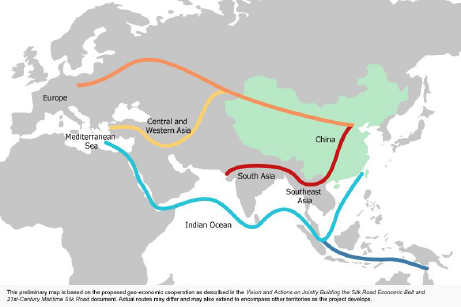
(source: Hong Kong Trade Development Council)
If the recommendations are implemented and a marine cluster in Hong Kong is strengthened, we forecast that the Hong Kong marine market premiums can double or even triple, getting close to HKD4bn. It will also elevate Hong Kong’s ranking to top 4 in the marine market in Asia Pacific region (see Appendix 3).
Section 3 – Captive Insurance
3.1 Our Goal
To establish Hong Kong as a world class and leading Captive domicile by 2020 with the aim of over 5-10 captives licensed per year and 50 total captives by 2025. This is a realistic goal given the number of organisations in Mainland China and the surrounding region that have the size, scale, risk profile and the relevant growth plans to utilise captives.
Hong Kong should be an attractive domicile for offshore captives from Greater China, around the region and the world along with an attractive onshore domicile for Hong Kong based corporates.
For Hong Kong to establish an active captive strategy driven by the IIA that is funded with dedicated resource tasked with promoting, developing and increasing the size of the Hong Kong captive market.
3.2 Our Strengths / Opportunities
3.2.1 Internationalisation of RMB
With Mainland China's initiative to internationalise the RMB comes the potential for Hong Kong to increase its financial product offerings. With close financial links, Hong Kong is the easiest and closest place to help facilitate China's desire for internationalistion of its currency. This leads to the potential for the growth of captives in Hong Kong. With an increasing amount of international exposure in Mainland China, there is a market for companies with a desire to maintain a captive’s risk exposure in RMB to eliminate the risks of currency exchange rate fluctuations. American companies such as Procter and Gamble, Pfizer and General Electric, that would traditionally establish a captive closer to home, may have needs to cover their Mainland Chinese based exposure with an Asian based captive. Hong Kong is a perfect location for these companies given its close ties to Mainland China and its own establishment as a global offshore centre for the RMB.
Moreover, Hong Kong is an important regional and global hub for financing, lending, asset and fund management, with a wide array of RMB based products already available, captive managers of RMB denominated captives would have a collection of leading services to use. Having the potential to operate a captive in RMB (amongst other currencies), in a location with stability, a depth of financial services and close links with Mainland China would give Hong Kong the edge over any other global competitor.
Coupled with the potential for foreign captives in Hong Kong is the potential influx of Mainland Chinese captives. Hong Kong is already the preferred offshore platform for many Mainland companies (many of these companies are already listed on the Hong Kong stock exchange) and is seen as a gateway between Mainland China and the rest of the world. Hong Kong already has a mature and sizeable insurance industry with scope for an influx of expertise in captive management if and when necessary.
Hong Kong's direct link with Shanghai and Shenzhen stock exchanges as well as possessing the third largest Asian stock market highlights the potential investment opportunities for any captives located here. With the position as an international hub for the RMB comes the potential of a broadening of potential clients. Many Mainland Chinese businesses have limited access to foreign expertise and resources. The incentive to create a captive offshore is therefore high. Yet, the increasing use and range of products available in RMB in Hong Kong provides a realistic incentive for many Mainland Chinese companies (or other companies with considerable risk exposure in RMB denominated assets) to establish a captive in Hong Kong.
3.2.2 Supporting the Belt and Road Projects and Initiatives
Major Mainland Chinese organisations are expanding their footprint in developing countries in the region. Insurance is a key economic enabler of growth, as it increases the business’ resiliency against natural and other perils and protects the corporate balance sheet. The current procurement practice of insurance for overseas operations can be non-compliant and/or often heavily reliant on local insurance companies in developing markets. This in turn exposes the operations to undue financial and regulatory risks.
A compliant and fit-for-purpose global insurance programme provides a solution to the expansion needs. A captive would be central to this as it serves as a point of consolidation in terms of data collection, programme management and risk management.
3.2.3 Resilience and Sustainability
Companies that have captives are insuring against risks that are either difficult to insure or have taken a proactive stance in risk management by employing dedicated expertise. Mainland China as a whole has a significant lack of professional risk managers whilst Mainland Chinese companies have a significant amount of risk exposure, especially to natural catastrophes (typhoon, flood, earthquake, storms, drought and more) and business interruption. Large Mainland China based multinational companies have been in the process of identifying and quantifying their uninsured risks and have insofar found the risks significant. This is a critical exercise as top management understands the downside risk and impact on the balance sheet. As many of these companies are in emerging industries and locations where conventional insurers may have limited risk appetite or capacity, the only way to manage this risk and exposure would be through the creation of a captive. By creating a captive they would be safeguarding against disasters, protecting their business and providing a long term vision for stability and resilience. A captive would provide them with a focused business unit dedicated to managing their risks and mitigating risks posed in the future. With a rise in captives comes the awareness and management of risk, which can only be beneficial for the long term resilience and sustainability of businesses within the region.
3.2.4 Culture and Conduct
Promoting a risk management culture is key for long term sustainable business opportunities within the scope of the Belt and Road Initiative. The HKMA is promoting stability and integrity within the financial system while maintaining Hong Kong's status as an international financial center is also a focus. To do so it is targeting the maintenance and development of Hong Kong's financial infrastructure and maintaining currency stability within the framework of the Linked Exchange Rate system. Captives located in Hong Kong could provide security for a large amount of businesses in North Asia while also being able to increase the diversity of financial service offered in Hong Kong. Protecting against risk is vital for the sustainability of businesses in an ever riskier world. With the development of captive insurance companies comes a greater focus on risk management and a greater appreciation of the everyday risks faced by businesses.
3.2.5 Talent
More promotion by the Government and by the profession to the public regarding the possibility of a career in insurance underwriting to anyone who is interested without necessarily having a university degree. A lot of the current incoming recruits are graduates coming back from overseas (such as UK and Australia) where the insurance industry is widely publicised and well known.
Talent specific for captives – possibility of an 'in house' system – akin to the legal profession, where insurers (underwriters, claims professional) can move into a niche environment after having developed skills working in larger insurance companies. In the legal profession, this is an especially attractive option for lawyers who would prefer working environments where hours are more comfortable. In any case, whilst the number of currently experienced personnel in this area is limited in Hong Kong, there are a high number of qualified local graduates of economics, finance, accounting and legal courses who can take up this expertise.
Lastly, Hong Kong should create an 'incubator' for Captive Managers and service providers whereby office space is subsidized, start-ups can access the IIA easily along with incentives for hiring graduates and providing training. This incubator could also extend to other start-ups supporting the Insurance and Reinsurance sector.
3.2.6 Technology
With the potential of insurance and financial service expansion that captives bring the opportunity for the development of Financial Technology (FinTech) and Insurance Technology (InsureTech) within the insurance and risk management sector. Financial technology and Insurance Technology in Hong Kong has not been particularly successful in comparison to London and US Tech hubs. Captive creation could spark a series of new technological products focusing on risk management. With insurance companies placing ever greater impetus on data and technology there is a wide array of scope for these sorts of companies to develop. This potential development would provide jobs and would develop the FinTech/ InsureTech industry in Hong Kong immensely.
A captive 'hub' or 'cluster' would provide some push for the FinTech/ InsureTech industry through the need to develop bespoke in-house risk management tools and systems. There is a limited number of suppliers of claims, underwriting and general captive management systems at present. By creating a developed local captive market including captive management companies there would be demand for tailored risk management and captive management systems to be developed that would aid in the operation of captives.
3.2.7 Implementation
Hong Kong has traditionally been slow to promote the use of captives due to a lack of regulatory promotion, lack of incentives to compete with international domiciles and to a certain degree a lack of understanding from the financial and corporate sectors of the benefits of, and uses for, captives. The mature Asian captive markets of Singapore and Labuan have promoted these for a longer time and therefore have established themselves as hubs. They have led the way in providing incentives for captive creation while them benefitting from strategic locations within the Asia-Pacific region. What is more, Singapore is seen as a prominent insurance and reinsurance center and so more resources provide a greater depth of expertise in the reinsurance and captive market. Hong Kong could see this same 'cluster' effect once local captives exceed around 20, a number which is seen as a watershed in terms of demand for captive services, management services, asset management and regulator experience. Once this level is reached the cluster effect will take hold.
The success of Singapore within the Asia-Pacific region highlights the potential that Hong Kong has within Greater China. The focus should be on promoting the positives on offer in Hong Kong. Singapore places emphasis on their licenses when promoting itself as a location for captives. They have also benefitted from an inflow of Australian captives. Australia (a country with a mature insurance and captive industry) has contributed to making Singapore a hub and with that has come an expansion into reinsurance and captive management which are similar benefits that Hong Kong could realize in the near future. The Mainland Chinese companies, State Owned Enterprises (SOEs) and regulators traditionally might not have full confidence in captives; however, this view is changing, and we now see a great deal of opportunities for the growth of captives for Mainland Chinese companies and SOEs. However, the relaxing of restrictions and opening up of Mainland China to foreign companies means that the potential is there for Hong Kong to also host captives that support foreign companies’ growth and risk management programmes in Mainland China and the broader Asian region.
3.3 Our Weaknesses / Threats
Hong Kong faces natural competition from domiciles in the region and globally. We need more education for CEO's, C-suite and Risk Managers on the benefits and uses of captives. The general lack of risk management experience and knowledge in this area is a key issue for boards and companies. This is why we recommend the IIA takes some ownership to fill the information gap Hong Kong and Mainland Chinese corporates face when it comes to knowledge about captive insurance companies.
3.4 Our Recommendations
IIA to issue a guidance note as soon as possible for captives, covering topics such as captive management, captive operations, captive risk management and more.
IIA should have a 'sales' leader whom is tasked with actively promoting Hong Kong as a captive insurance and reinsurance centre. This role should specifically originate opportunities, support the application process and develop the business case for a Hong Kong captive. Creating supporting documentation and materials on the benefits of captives and the unique proposition of the Hong Kong captive domicile. How captives can drive better risk management within the group and promote soft advantages such as supporting the business by having the captive advise on business risks and providing solutions directly to the business.
It is necessary to have events in Hong Kong – through organisations such as HKFI, IIA, Hong Kong Insurance Law Association Limited, The Chartered Insurance Institute Hong Kong and other bodies promoting and supporting the Hong Kong insurance industry with active promotion by the industry through events/ talks / briefings. Conducting company visits and training/ information sessions for CEO/CFO/CRO to demonstrate and promote captives.
3.5 Macro-monetary environment in Hong Kong Favouring the Development of Reinsurance, Marine Insurance and Captive Insurance
Hong Kong has experienced huge inflows of capital in recent years. Shortly after the outbreak of avian influenza in the first half of 2003, capital from overseas and Mainland China have been flowing into Hong Kong significantly and steadily. Inflows taken up by the HKMA in the past 13 years have amounted to a total of around HKD1.2tn (about USD155bn). This is on top of those inflows absorbed by the banking sector which can be equally substantial.
Contrary to what has been reported in the media, these inflows are not hot monies which are supposed to be moving in and out quickly. These inflows have been persistent and have so far shown no inclination to leave Hong Kong. Many of these have gone into the local property and capital markets and may have contributed to the asset price appreciation. Against the background of ample supply of capital due to significant and steady inflows, it provides a favourable macro-monetary environment for the development of capital intensive businesses such as reinsurance, marine insurance and captive insurance. Such alternative channels of investment may also serve a useful purpose of alleviating some of the pressure on the local asset price appreciation.
Currently there are 102 Central Enterprises under the regime of State-owned Assets Supervision and Administration Committee of the State Council (SASAC). Assets under the supervision of SASAC amounted to RMB119,200bn. If Hong Kong can capture all or any part of these assets in captive insurance, the Hong Kong captive insurance industry will experience a huge growth.
Appendices
Appendix 1 – Global Marine Premium 2015
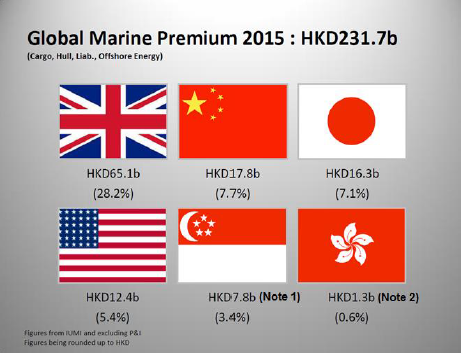
source: International Union of Marine Insurance (IUMI)
Note 1 – According to Monetary Authority of Singapore, the gross premiums of Singapore insurance fund in the “Hull and Liability” category in 2015 is 373.3 million Singaporean dollars (around USD 256.7 million).
http://www.mas.gov.sg/~/media/resource/data_room/insurance_stat/2015/AG2_2015.pdf
Note 2 – According to the Office of the Commissioner of Insurance of Hong Kong, the gross premium of underwriting results of direct & reinsurance inward business in the “Ships” category in 2015 is 2,456.8 million Hong Kong dollars (around USD 316.5 million).
http://www.oci.gov.hk/download/T_G1_2015.pdf
Appendix 2 – Top 10 Ship Registers
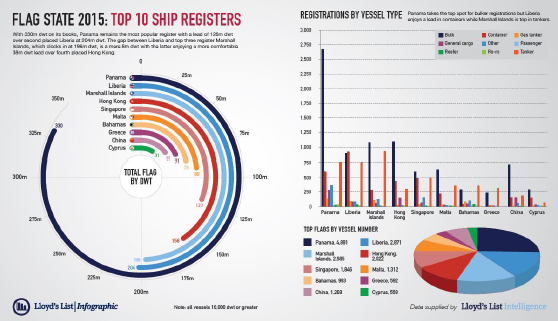
(source: Lloyd’s List Intelligence)
Appendix 3 – Marine Premium Breakdown by Country 2015
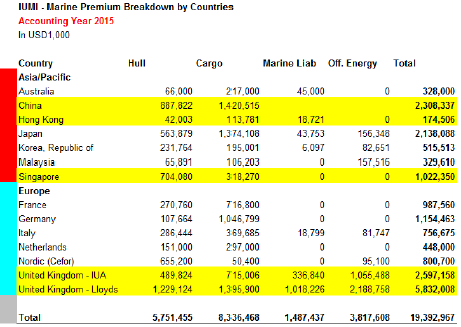
(source: International Union of Marine Insurance (IUMI))
About the Financial Services Development Council
The Hong Kong SAR Government announced in January 2013 the establishment of the Financial Services Development Council (FSDC) as a high-level and cross-sector platform to engage the industry and formulate proposals to promote the further development of Hong Kong’s financial services industry and map out the strategic direction for development. The FSDC advises the Government on areas related to diversifying the financial services industry, enhancing Hong Kong’s position and functions as an international financial centre of our country and in the region, and further consolidating our competitiveness through leveraging the Mainland to become more global.
Contact us
Units 3104-06, 31/F, Sunlight Tower
248 Queen’s Road East
Wan Chai, Hong Kong
(852) 2493 1313
www.fsdc.org.hk
0
YuanName:
Mobile Number:
Comments…
After your successful submission, our staff will soon be in touch.


